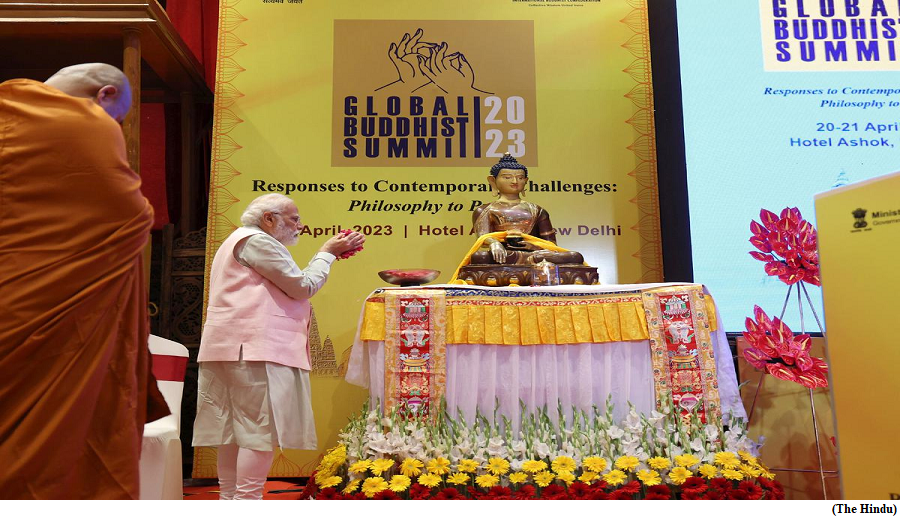Buddhism, India’s soft power projection tool (GS Paper 2, International Relation)

Context:
- Recently, at the global Buddhist summit Indian Prime Minister laid emphasis on the continuing relevance of the Buddha’s teachings in today’s world.
- The summit was a significant opportunity for India to project and connect with the Buddhist population around the world, thereby strengthening the country’s soft power.
Details:
- Recently, a two-day global Buddhist summit in New Delhi (April 20-21) was organised by the Ministry of Culture in collaboration with the International Buddhist Confederation.
- The summit saw the participation of key figures from the global Buddhist community, including the Dalai Lama.
- The Delhi summit’s theme, “Responses to Contemporary Challenges: Philosophy to Praxis”, also highlights India’s attempts to provide an alternative to contested global politics, with morality as the guiding principle.
- It saw a diverse group of 171 foreign delegates from South Korea, Thailand, Cambodia, Japan, and Taiwan, along with 150 delegates from Indian Buddhist organisations.
India’s Buddhist diplomacy:
- The Indian government has been actively investing in its Buddhist diplomacy efforts, with a focus on promoting tourism through the development of the “Buddhist tourist circuit”.
- Additionally, Indian PM has made it a point to visit Buddhist sites during his Southeast and East Asian visits. By hosting such a high-profile event, the Indian government hopes to demonstrate its commitment to preserving and promoting Buddhist culture and heritage, as well as strengthening ties with the global Buddhist community.
- With its strong historical and cultural ties to Buddhism, India is well-positioned to play a leading role in shaping the discourse around Buddhist issues on the global stage.
Potential:
- Buddhist diplomacy has the potential to promote regional cohesion, given that nearly 97% of the global Buddhist population is based in Asia.
- During the Cold War, China effectively used Buddhist diplomacy to engage with its neighbouring countries, and it continues to employ this approach to gain legitimacy for its Belt and Road Initiative.
- As India and China compete to dominate the Buddhist heritage as a tool for soft power, India holds an advantage due to the faith’s origins in the country.
- However, despite being home to a number of key Buddhist sites, such as Bodhgaya, Sarnath, and Kushinagar, India has struggled to attract Buddhist tourists, who tend to favour sites in Thailand and Cambodia.
Cultural & civilizational links:
- India’s efforts to position itself as a great power committed to cooperation rather than coercion are rooted in its deep historical and cultural ties to the region.
- The current government’s guiding principles for foreign policy, Panchamrit principles include “Sanskriti Evam Sabhyata” which means cultural and civilizational links, which were highlighted during the Delhi summit.
- By laying an emphasis on cultural and civilisational ties, India seeks to promote greater understanding and cooperation between nations and to demonstrate the unique role it can play in shaping the region’s future.
China factor:
- India recognises the importance of Buddhism as a means of conducting public diplomacy and has utilised it to its advantage. However, to maintain its edge over China, more action is needed.
- China is actively seeking to exert control over the appointment of the next Dalai Lama, which would be a blow to India’s efforts to project its soft power through Buddhism. India must act to ensure that it remains a key player in the global Buddhist community.
Future roadmap:
- To further strengthen its Buddhist diplomacy, India should continue promoting Buddhism at the highest levels of government, while also organising cultural events to showcase the country’s rich Buddhist history.
- The Indian Council for Cultural Relations (ICCR) could play a significant role in promoting such events within and outside India.
- Additionally, India should work to strengthen its ties with key Buddhist institutions and leaders around the world. The Delhi summit was a step in the right direction, providing a valuable opportunity for cultural exchange and the sharing of ideas.
- India also needs to utilise the reach of Bollywood in promoting its Buddhist heritage. China, with its influence over Hollywood, has completely dominated the narrative around Buddhism through cinema. In contrast, India is behind in this domain; there have not been any efforts made through cinema.
Way Forward:
- India’s G-20 presidency could be used to promote Buddhist diplomacy on a bigger scale through various cultural meetings, especially as Buddhist teachings align with the motto of India’s G-20 presidency, ‘One Earth, One Family, One Future’.
- As Buddha was the first diplomat of peace, his teachings of peace and cooperation in these tough times can become the guiding light of Indian diplomacy on the world stage.


